Body length: 12.5–13 mm.
Eyes: eye interommatidial setaeseta:
a sclerotized hair-like projection of the cuticle
absent, eye deeply emarginateemarginate:
notched at the margin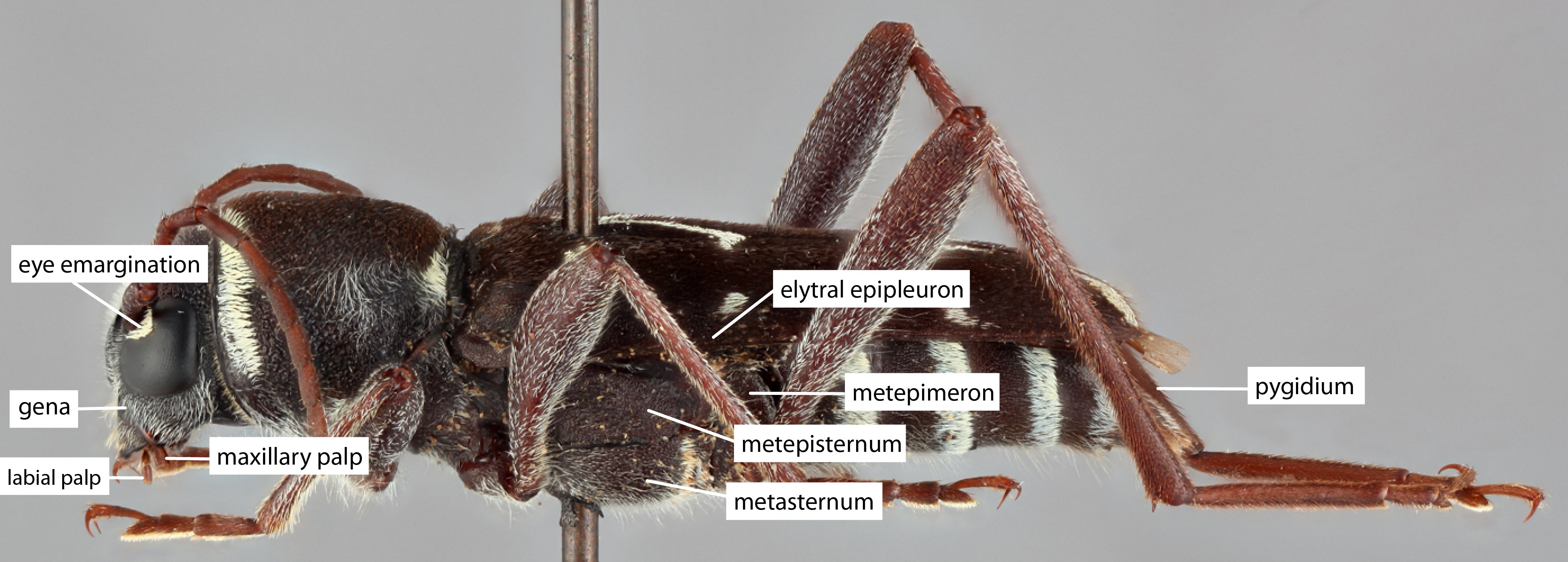 > half width, eye ommatidial density coarse.
> half width, eye ommatidial density coarse.
Antennaeantenna:
in larval and adult insects, paired segmented appendages, borne one on each side of the head, functioning as sense organs and bearing a large number of sensilla
: antennal length reaches between basebase:
the part of any appendage or structure that is nearest the body
and end of elytraelytron:
the leathery forewing of beetles, serving as a covering for the hind wings, commonly meeting opposite elytron in a straight line down the middle of the dorsum in repose
, antennal flagellar segments elongateelongate:
much longer than wide
, scapescape:
the first proximal segment of the antenna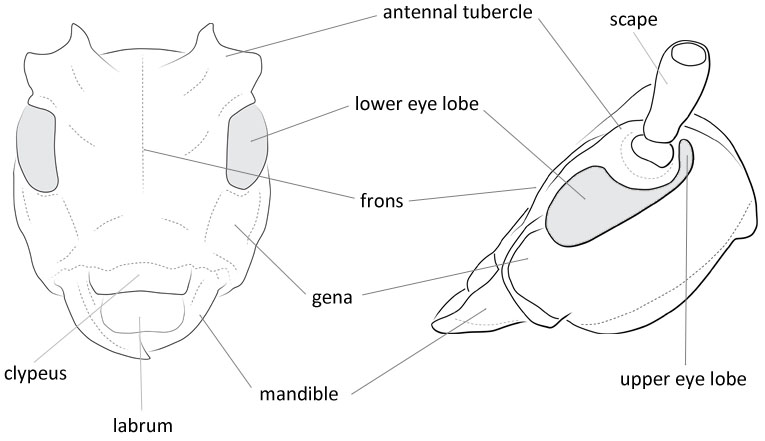 smooth/punctate at apexapex:
smooth/punctate at apexapex:
end of any structure distad to the base
, antennal scapescape:
the first proximal segment of the antenna ≥ segment 3.
≥ segment 3.
Pronotumpronotum:
the upper and dorsal part of the prothorax
: pronotumpronotum:
the upper and dorsal part of the prothorax
shape transversetransverse:
broader than long
or subquadratesubquadrate:
not quite a square
, pronotumpronotum:
the upper and dorsal part of the prothorax
lateral armature absent.
Prosternum: prosternal processprosternal process:
a posterior extension of the prosternum between the coxae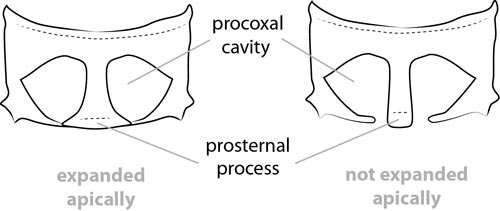 dilated at apexapex:
dilated at apexapex:
end of any structure distad to the base
, procoxal cavities closed posteriorly.
Elytraelytron:
the leathery forewing of beetles, serving as a covering for the hind wings, commonly meeting opposite elytron in a straight line down the middle of the dorsum in repose
: elytral length reaching or close to end of abdomen, elytral apicesapex:
end of any structure distad to the base
rounded or truncatetruncate:
cut off squarely at the tip
, elytral color brown or reddish, elytral color pattern absent.
Legs: visible tarsomerestarsomere:
subdivision or article of the tarsus, usually numbering from two to five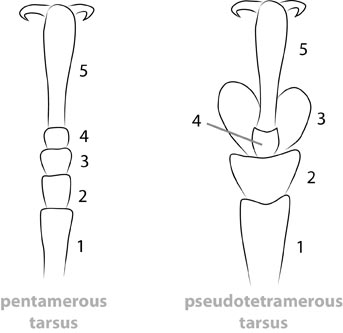 : 4, femora slender, protibial spursprotibial spur:
: 4, femora slender, protibial spursprotibial spur:
sclerotized spine(s) located at the distal tibia; can be single, double, or absent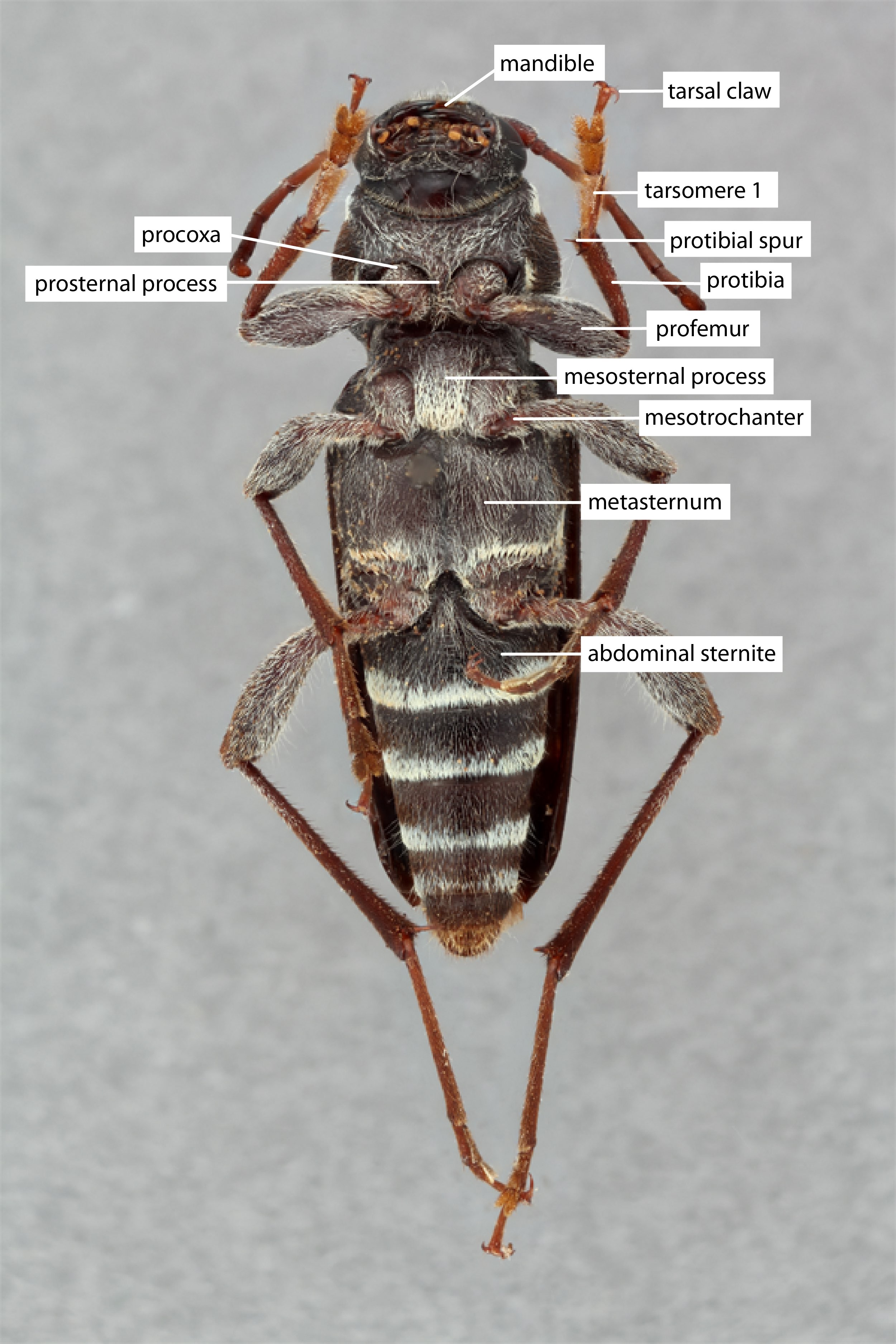 : 1, tarsal clawstarsal claw:
: 1, tarsal clawstarsal claw:
usually paired claws of the pretarsus, at the distal end of the leg simple.
simple.
Body depressed, parallel. Head transversetransverse:
broader than long
, level between antennal insertions which are distant, depressed and ensconced in the deeply emarginateemarginate:
notched at the margin , large, coarsely facetted eyes; genaegena:
, large, coarsely facetted eyes; genaegena:
the part of the cranium on each side below the eye extremely narrow. Antennaeantenna:
extremely narrow. Antennaeantenna:
in larval and adult insects, paired segmented appendages, borne one on each side of the head, functioning as sense organs and bearing a large number of sensilla
with fifth segment distinctly longer than each of the proceding; fourth longer than third. Prothorax depressed, expanded at sides between middle and apexapex:
end of any structure distad to the base
. Anterior coxal cavities closed posteriorly, angulate externally; prosternal intercoxal process moderately wide, depressed, broadened apically; middle coxal cavities closed externally; mesosternal intercoxal process broad, flat. Abdomen with segments successively decreasing markedly in length, first segment nearly one-half as long as remaining combined (Gressitt 1951Gressitt 1951:
Gressitt JL. 1951. Longicorn beetles of China. Longicornia, Paris 2: 1–667, 22 pls.).
Differs from Paratimia in having the body more flattened, particularly the head and prothorax, and with larger, more coarsely faceted eyes, the prothorax more expanded anteriorly, the elytraelytron:
the leathery forewing of beetles, serving as a covering for the hind wings, commonly meeting opposite elytron in a straight line down the middle of the dorsum in repose
broader and with straighter margins.
Palearctic: Yunnan Prov. China
Pinus yunnanensis
Monotypic. Very rarely collected.
Proatimia Gressitt, 1951Gressitt, 1951:
Gressitt JL. 1951. Longicorn beetles of China. Longicornia, Paris 2: 1–667, 22 pls.